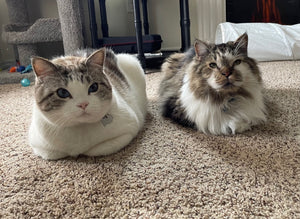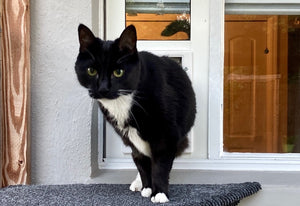How Much Should You Feed Your Cat?
While bigger or “chunky” cats are very cute and seem cuddlier, it is unhealthy for cats to gain massive amounts of weight. Obesity has been a growing problem among pet owners as there has been less time to exercise our pets while still feeding them the same amount.
Cats seem to be the biggest victim and culprit of overfeeding. Many cat lovers do not feed their cats the right amount of dry or wet food, which can lead to overeating. On top of that, cats are known to beg for food every hour of the day, and many are unable to regulate their eating.
All together, cats are at a higher risk of improper feedings. So how much should you feed your cat? How often? What kind of food? How do you measure it?

Dangers of Overfeeding Your Cat
Before we dive into how much you should feed your cat, we should first go over why a proper feeding schedule is so important.
An overweight cat is at a higher risk of many health conditions, including kidney damage and higher blood pressure. Obese cats also suffer from osteoporosis and other joint and mobility issues that greatly impact their quality of life.
Additionally, veterinarians warn that a cat at a healthier weight is easier to treat than one that is chunky. Many medications have doses based on your cat’s weight. A heavier cat means having to give a greater dose, which will be at a greater cost to you.
Plus, the guidelines for these medications are based on your cat’s ideal weight. So if your cat is fatter, your veterinarian will have to do some guesswork to figure how to adjust the medication. This can lead to improper doses and imprecise medical care.
How Much Should You Feed Your Cat?
If you look at the back of your cat food, you will often see a recommended serving size for each cat. However, these serving one-size-fits-all sizes are too general to be applicable to every cat. The amount they recommend is often based on the calorie needs of an unneutered male cat, which would be inaccurate for female cats, neutered cats, or any cats with health issues.
Because every cat has their own unique needs, you should consult with your veterinarian about what serving size they recommend. There are many factors that can affect how much you should feed your cat, including:
- Age: Adult and senior cats have less nutritional needs than kittens.
- Size: Smaller cats need less food than larger framed cats.
- Activity level: a cat who moves around more (and burns more calories from exercise) will need more food than a cat who has a lower metabolic rate.
- Indoor vs Outdoor: a cat who has access to the great outdoors (like having access to a cat flap) will burn more calories than a cat who only has a few rooms to roam.
- Health Status: Some diseases and health conditions lower or raise your cat’s metabolic rate.
- Reproductive Status: A cat who is pregnant or nursing needs significantly more calories than a cat who is not. Additionally, spayed and neutered cats have slower metabolisms due to a decrease in hormones, meaning that they need fewer calories on average.
Many veterinarians recommend starting out with two feeding times per day, splitting 5.5oz of cat food between each (3.3oz for smaller cats). From there, adjust the amount your cat eats based on whether or not they start to gain weight.
If you need to start cutting back on the amount of food your cat eats, we recommend adjusting the serving size slowly. A sudden decrease in food is likely to cause stress to your cat and increase begging. To reduce the serving size, remove about a third of a teaspoon from the current serving, then wait a few weeks for your cat to adjust to the smaller portion. Then repeat until your cat’s food is down to a healthy amount.
Remember to reduce your cat’s food at a slow, moderate place even if they are overweight. It is healthy for a cat to only lose ½ pounds per a week when on a diet. You can also help a cat to lose weight by increasing their activity levels by playing with them more or giving them cat door access to an enclosed catio.
How Often Should I Feed My Cat?
Like humans, cats have a simple stomach structure. That means that they can get hungry throughout the day and need to eat multiple times in a twenty-four hour period.
We recommend feeding your cat twice a day–once in the morning and once in the evening. Depending on the nature of your cat, they will either scarf everything down right away or graze throughout the day. Both are totally normal behaviors.
What Kind of Food Should I Feed My Cat?
At the end of the day, as long as the food you give your cat is made for cats and not poisonous to consume, then you can feed them anything. But there are some benefits to serving them certain foods.
Many veterinarians recommend wet food over dry, as it is not only higher in protein but also contains a higher water content that will keep your cat hydrated. Dry food has more carbohydrates, which can more easily lead to overfeeding.
How Do You Measure the Serving Size For Your Cat?
While many pet owners just use measuring cups, many veterinarians recommend measuring your cat’s food intake by weight. A kitchen scale can more accurately measure the right serving size, while a cup lends itself to imprecise measuring.
While you can use either method, make sure that the measuring cup you use to measure your cat’s food is an actual measuring cup. Using an old coffee mug or a designated red solo cup will often lead to overfeeding your cat.




